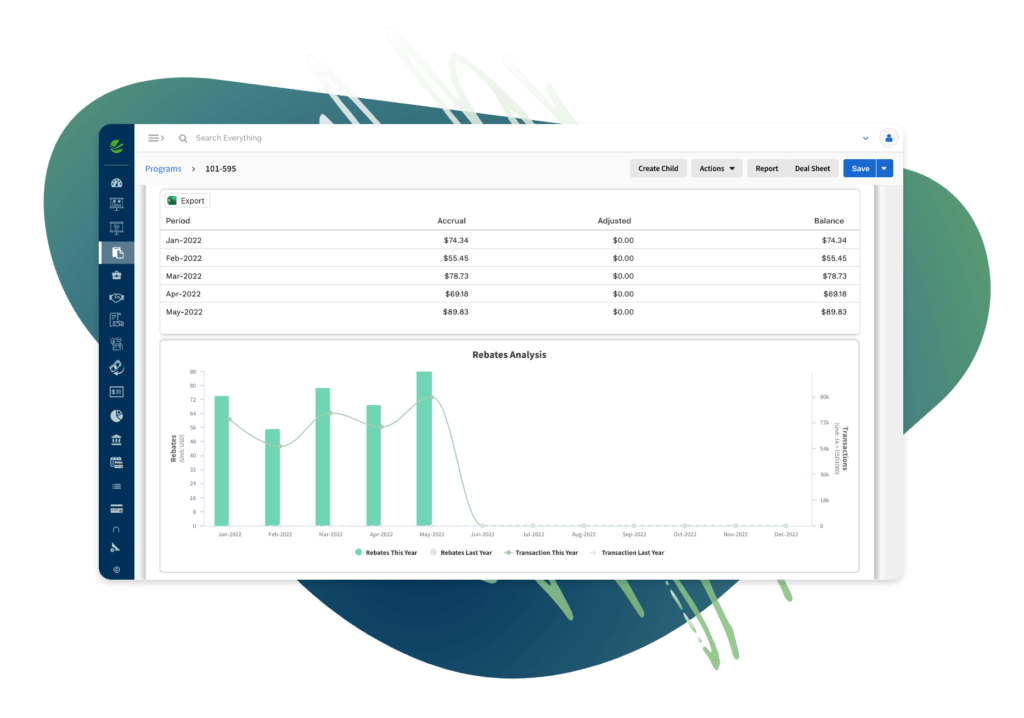Pricing is the battleground where wholesale distributors compete for profitability and market share. More distributors…

Elevate Your Rebate Game with Technology
Rebates and incentives play a vital role in fostering relationships among customers, sales teams, vendors, and various trading partners. Many distributors manage their rebates through manual processes, general purpose software, or a combination of both. Unfortunately, rebate programs often involve substantial overhead, vary depending on customer contracts, and are frequently susceptible to risks and errors.
Rebate incentive management programs should span across agreements, catering to the needs of the entire organization – from pricing analysts and sales representatives to rebate managers and finance teams. After your company has signed contracts and established programs, managing the rebate process should be seamless – from inception to completion. This includes automated payments, audit trail access, partner portals, on-demand reports, and deductions management.
We asked Mike Bernard, Chief Marketing Officer at Vendavo, a global market leader in B2B pricing, selling, and rebate management solutions, to provide some insights on rebate management.
Rebate Management is a Necessity
“Rebates are an important part of a distributor’s business model,” says Bernard. “Using a specific rebate management solution has become imperative for leading distributors.” Efficiency and accuracy are often what leads distributors to implement rebate management. “Managing rebates manually can be time-consuming and labor-intensive. Software automates many processes, streamlining rebate management and freeing up resources for other essential tasks. Rebates are also prone to human errors, which can lead to incorrect calculations, missed payments, and discrepancies.” Software reduces the risk of errors by automating calculations and tracking relevant data.
Rebate management software also helps you with compliance and scale. “Rebate programs often involve complex agreements and terms that must be adhered to,” says Bernard. “Software helps distributors maintain compliance by ensuring that rebates are calculated, tracked, and paid according to the agreed-upon terms.” And rebate management only gets more complex with growth. “As a distributor grows and manages more customers, products, and rebate programs, manual processes often become unmanageable. Software solutions, like those offered by Vendavo, can easily scale to accommodate increased complexity and volume, ensuring efficient rebate management regardless of business size.” These abilities also improve your relationships with customers and vendors. “Timely and accurate rebate processing is crucial for maintaining strong relationships because your partners prefer to work with distributors who carefully manage their rebates. It promotes trust across the board.”
It can also be difficult to stay on top of rebates if you’re using spreadsheets and standard ERP systems without a specific rebate management solution. “Rebate management software provides a centralized platform to monitor all aspects of the rebate program, offering real-time insights into performance, accruals, and payments,” says Bernard. “This visibility enables distributors to make informed decisions and identify areas for improvement. Software can generate comprehensive reports and analytics on rebate program performance, helping distributors identify trends, assess the effectiveness of various incentives, and make data-driven decisions to optimize their programs.”
Effective Vendor and Customer Rebates Start with Deal Management
“Rebate programs are about rewarding desired behavior,” says Bernard. By effectively managing rebates, distributors can optimize their incentive programs, drive sales, and enhance customer satisfaction. The more effectively you can streamline vendor and customer rebate management through deal creation, automated approval workflows, status reviews, and communication tools, the more deals you can influence through your rebate program.
Customizable Deal Creation
“The first step in effective rebate management is creating deals based on agreements that cater to your unique business,” says Bernard. With the right solution, these agreements can be custom or templatized, allowing you to define various rebates, allowances, payments, and formulas. “We like using templates for speed as distributors can quickly and efficiently set up new deals, saving time and reducing the potential for errors. But there are times when you need to adjust based on the situation as well.”
Automated Approval Workflows
“Streamlining the approval process is key to efficient rebate management,” says Bernard. “Setting up automated approval workflows helps ensure that all relevant parties review and approve deals before they go live. This not only speeds up the approval process but also enhances compliance by ensuring that each agreement aligns with company policies and guidelines.”
Reviewing Rebate Statuses, Summaries, and Activities
Monitoring the performance of your rebate programs is essential for optimizing incentives and driving sales. “It is very important for distributors to regularly review rebate statuses, summaries, and activities,” says Bernard. “This kind of review provides valuable insights into the effectiveness of each deal, allowing you to identify areas for improvement and make data-driven decisions to enhance your rebate programs.”
Enhancing Communication with Comments and Notifications
Effective communication is key to successful rebate management. By adding comments and sending notifications on deals and user activities, distributors can keep all stakeholders informed and engaged throughout the rebate lifecycle. “Transparency fosters collaboration, ensures timely actions, and maintains strong relationships with both vendors and customers,” says Bernard. “Many companies forget about closing the loop with effective notifications, but this is a critical element of a comprehensive approach to rebate management.”
Bid Analysis, Margins, and Price Lists
When you have an open bid that you are working hard to close, it can be easy to forget about rebates, margins and profitable pricing. Your energies become focused on what it takes to be competitive in your bid. That’s where a great rebate management solution comes in, helping you stay focused on the elements of your rebate program that can keep you competitive and profitable with margin analysis, bid review and current price lists.
Reviewing Bids and Protecting Net Margin
“It isn’t easy to stay on top of your bids. But when you get to the stage of the deal where you have an open bid you’ve already done a lot of the hard work in sales and now it is time to maximize that work,” says Bernard. To optimize profitability and ensure a healthy bottom line, distributors need to carefully review bids and quotations, focusing on net margin protection. “With a system to thoroughly analyze each open bid, distributors can identify potential risks, assess the feasibility of the proposed terms, and make informed decisions that safeguard their net margins.”
Analyzing Margin Impact and Authorizing Bid Requests
“Of course, sales management needs to help in this process,” says Bernard. Before approving any bid request, it’s essential for distributors to evaluate the potential margin impact of the proposed deal. This involves comparing the expected revenue against the associated costs, considering any related rebates, allowances, and other incentives. Doing this work manually can take so much time that it can negatively affect sales response times. Unfortunately, distributors without rebate management systems often skip over this analysis. “When a sales manager has rebate management capabilities, they can let the sales reps sell and authorize bid requests that ensure each deal aligns with their overall business objectives and profitability goals.”
Maintaining Price Lists and Approving Margin-Driven Price Changes
Price list maintenance is another critical aspect of effective rebate management. “The real point of an optimized price list is that it is too much to ask each of your reps to know everything they need to know about current market conditions, product availability, and customer demand,” says Bernard. Price optimization and list management ensures you maintain your margins in each deal. “If you can easily stay up to date on your price lists, you become much more agile in approving any necessary price adjustments to win deals while protecting your margins. And customers generally prefer that you are proactive with competitive bids rather than just responding to external factors.”
Flexibility to Match Your Rebate Programs
“One of the biggest challenges with managing rebates is dealing with the many types of rebate programs distributors work through,” says Bernard. “Your software solution needs to allow you to centrally create and manage channel and vendor incentive programs for your customers or products respectively. We’ve seen everything from flat rebate programs, volume-based incentives, growth-oriented rebates, delivery-based incentives, retention goals, ship-and-debit, and much more.”
For example, distributors often work with ship-and-debit rebates. It is very common for a durable goods distributor to purchase items from a vendor at a negotiated in-stock price. However, when working a large bid, that in-stock price may be higher than what is required to win the deal. “You can’t always approach a deal with simple volume targets in mind,” says Bernard. “There are many reasons why a distributor needs more immediate assistance to be competitive in a big deal and a ship-and-debit structure can help with short-term cash flow and predictability.” In a ship-and-debit rebate structure, the distributor works with vendors for pricing support to be able to sell items for less than their in-stock pricing. Then after shipping, the distributor creates a rebate claim based on the amount sold and the vendor can issue a rebate.
“There are so many moving parts in rebate programs that I can’t imagine how a distributor would even try to maximize their rebates and incentives without software,” says Benard. Enormous complexity arises when a manufacturer has multiple types of rebates and incentives applicable to a single transaction. For instance, a manufacturer may offer volume, mix, and growth rebates to the distributor while also providing volume rebates to the end-user. Additionally, the ship-and-debit claims outlined above might be involved in the same transaction. In such scenarios, calculating the net price for these sales becomes challenging as it requires considering all the applicable rebates and incentives.
“You don’t want to be guessing about your pricing and profit margins, especially when margins are thin to begin with,” says Bernard. To accurately determine the net price, distributors must carefully track and manage each type of rebate, ensuring that all relevant discounts are factored into the final calculation. “It’s too much to do manually, but with a rebate management system you have automation around your programs and record-keeping. This helps distributors maximize their rebates while offering accurate pricing, maintaining healthy profit margins, and fostering strong relationships with both manufacturers and customers. There is a very high ROI from investing in a robust rebate management software which can greatly assist in streamlining this process, automating calculations, and reducing the risk of errors.”
Making Your Rebate Management Easier and More Profitable
As you can see, manual rebate management presents significant challenges for distributors. To maintain strong relationships with vendors and customers, optimize incentive programs, and safeguard profit margins, it is crucial for distributors to invest in a robust rebate management solution. A solution such as Rebate and Channel Manager from Vendavo streamlines the entire process, from deal creation and approval workflows to tracking performance and ensuring accurate calculations and payments. By automating many of the time-consuming tasks associated with rebate management, distributors can allocate resources more efficiently and focus on growing their core business.

Moreover, a rebate management solution enhances visibility, compliance, scalability, and effective decision-making by providing valuable insights and analytics. This empowers distributors to make data-driven choices that improve their rebate programs and ultimately drive sales. By leveraging a comprehensive rebate management solution, distributors can successfully navigate the intricate world of rebates and incentives, fostering long-lasting partnerships with vendors and customers while ensuring sustained growth and profitability.



